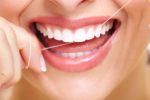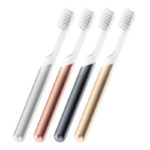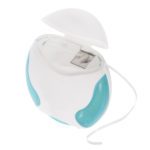Many people don’t know how to use interdental brushes. Read on and you will find out the proper technique to use.
Which size of interdental brush is the best?
Overall,the best interdental brushes are the ones which you can easily squeeze into your interdental space without any strong resistance or pain. However, due to inflammation and swelling of your gums, at first, this process can certainly be unpleasant. The ideal would be to consult a dentist on the thickness of the brushes that suit you best. With the assistance of a special professional probe, your dentist or dental hygienist can measure the size of each interproximal space. This way they determine optimal interdental brushes for you. Furthermore, the specialists also may give you professional flyers with detailed instructions on the proper use of interdental toothbrushes.
With the assistance of a special professional probe, your dentist or dental hygienist can measure the size of each interproximal space. This way they determine optimal interdental brushes for you. Furthermore, the specialists also may give you professional flyers with detailed instructions on the proper use of interdental toothbrushes.
Read more about why you should use interdental brush.

They also provide information about general oral hygiene, as well as motivate you for its regular maintenance. If for some reason you can not schedule a dental appointment, it is advisable that, for starters, opt for thinner brushes. While you gums are swollen, this is the least painful and but yet effective solution. At home, you can easily estimate the right sizes of brushes yourself. Take a trial set of interdental brushes and simply try out all different sizes. People who have crowns and bridges or lack some teeth, usually have gaps between teeth in different sizes. So, you can buy a kit that includes interdental brushes in a few basic dimensions. Set of brushes of different sizes provide the optimum cleaning for each gap.
Interdental toothbrush is recommended to be used as a supplement to conventional brushing. They are also a must for all those wearing fixed braces. So, after each thorough brushing with toothbrush made with soft fibers, you should also clean all interproximal gaps between teeth. In the absence of time and patience, most people rarely (if at all) practice to regularly use interdental brushes. But, in many clinical trials it has been proven that everyday use of interdental brush, together with manual toothbrush and correct brushing technique, may give very satisfactory results in terms of your oral hygiene and health.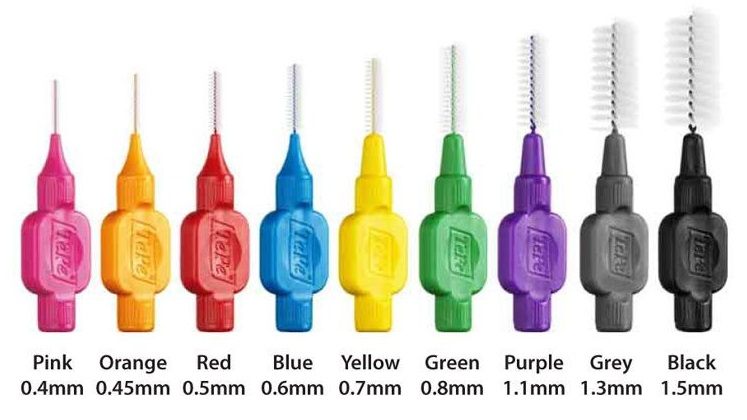
How to use interdental brushes with the right technique of cleaning
 Unfortunately, the most critical points in your mouth can not be properly cleaned with any toothbrush. And these points are the primarily place where gum and periodontal disease start developing. Interdental brushes are used when interproximal spaces are wider and where dental floss is not effective. That is because floss does not clean all areas completely, such as side surfaces of the back teeth which are naturally concave. So, these small specially designed brushes can easily clean plaque from these hard to reach areas. Once the hygiene of your teeth and gums becomes thorough and everyday practice, there is no possibility that the bacteria from plaque develop their harmful effect on your oral tissues.
Unfortunately, the most critical points in your mouth can not be properly cleaned with any toothbrush. And these points are the primarily place where gum and periodontal disease start developing. Interdental brushes are used when interproximal spaces are wider and where dental floss is not effective. That is because floss does not clean all areas completely, such as side surfaces of the back teeth which are naturally concave. So, these small specially designed brushes can easily clean plaque from these hard to reach areas. Once the hygiene of your teeth and gums becomes thorough and everyday practice, there is no possibility that the bacteria from plaque develop their harmful effect on your oral tissues.
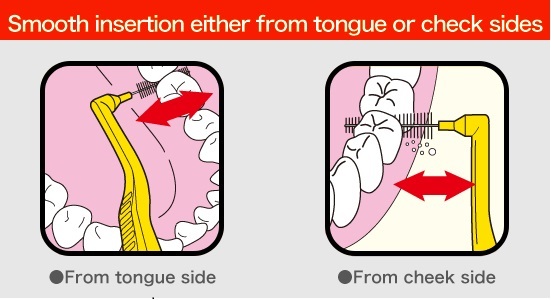 Do not be surprised that upon first use, interdental brushes often cause short-lived bleeding. This is quite normal and common in people who have never used these brushes. Specifically, in gaps between their teeth, there is a big amount of food particles and plaque full of bacteria. Therefore, the gums are constantly mildly inflamed. Also, blood vessels in them are filled with blood. So when introducing interdental brushes in that space, the gums react with bleeding. Thus, by daily cleaning of these areas we will remove food and bacteria which are a source of infection and cause of inflammation. Proper implementation of oral hygiene gradually decreases this bleeding. And after some time (usually in about 10-14 days) it completely disappears. The reduction of bleeding can serve you as a way of controlling the efficiency of your oral hygiene. The cessation of bleeding indicates the absence of plaque and gum inflammation, which means that we cleaned our interdental spaces well.
Do not be surprised that upon first use, interdental brushes often cause short-lived bleeding. This is quite normal and common in people who have never used these brushes. Specifically, in gaps between their teeth, there is a big amount of food particles and plaque full of bacteria. Therefore, the gums are constantly mildly inflamed. Also, blood vessels in them are filled with blood. So when introducing interdental brushes in that space, the gums react with bleeding. Thus, by daily cleaning of these areas we will remove food and bacteria which are a source of infection and cause of inflammation. Proper implementation of oral hygiene gradually decreases this bleeding. And after some time (usually in about 10-14 days) it completely disappears. The reduction of bleeding can serve you as a way of controlling the efficiency of your oral hygiene. The cessation of bleeding indicates the absence of plaque and gum inflammation, which means that we cleaned our interdental spaces well.
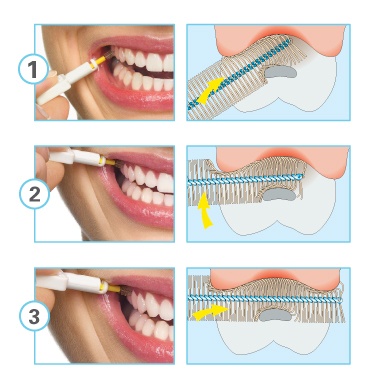 If we try to clean our interproximal spaces too harsh, there is a possibility to cause injury to the teeth or gums. Therefore, a proper technique of brushing has the main emphasis not to cause the damage of any oral tissues. You can achieve the complete removing of plaque between teeth with movements back and forth with interdental toothbrushes. Also, it is much easier to reach side surfaces of back teeth with flexible than hard interdental brushes. It is ok to feel just a small pressure when introducing the brush into the interdental space. Remember that you must never push the brush into the space by force, because you can seriously damage the gums.
If we try to clean our interproximal spaces too harsh, there is a possibility to cause injury to the teeth or gums. Therefore, a proper technique of brushing has the main emphasis not to cause the damage of any oral tissues. You can achieve the complete removing of plaque between teeth with movements back and forth with interdental toothbrushes. Also, it is much easier to reach side surfaces of back teeth with flexible than hard interdental brushes. It is ok to feel just a small pressure when introducing the brush into the interdental space. Remember that you must never push the brush into the space by force, because you can seriously damage the gums.
At the entrance into the interproximal space, set the top of the brush of appropriate size at an angle of 90 degrees to the gums. Then, gently slide it into the beginning of the space, looking for the angle at which it can thrive further without pressure. This angle is a bit different in every space. Then gently push it through entire space and then pull it out. In each space this is enough to be done at least once, but best few times. After cleaning each gap place the brush under running warm water, and continue to clean the next gap and so on. After completing the cleaning of all teeth rinse all brushes that you used and leave them to dry until the next use.
Watch this Video on How to Use an Interdental Brush:
